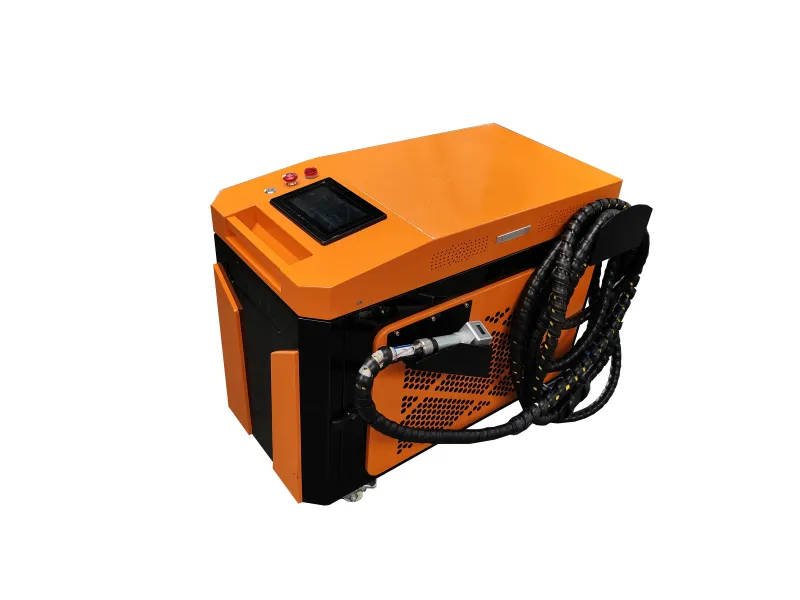Our laser cleaning machine uses the interaction of high-energy laser beams with pollutants (such as paint) to achieve efficient, environmentally friendly and accurate cleaning. It is gradually innovating traditional paint removal technology to make cleaning easy and efficient.
Ⅰ. The precise effect of lasers and pollutants:
Our laser cleaning machine uses high-energy beams of specific wavelengths (such as nanosecond and picosecond lasers) to illuminate the surface to be cleaned. After pollutants (such as paint and rust layers) absorb the laser energy, the following process occurs.
Thermal ablation: Pollutants quickly heat up to the gasification point, and instantly vaporize or decompose into tiny particles.
Plasma shock: The laser energy forms a rapidly expanding plasma, which generates a shock wave that peels the pollutant fragments off the substrate.
Difference in thermal expansion: The coefficient of thermal expansion of the pollutant and the substrate is different, and the laser thermal effect causes the pollutant to “shake off”.
This process does not require chemical solvents or mechanical contact, and cleaning is only achieved through photophysical reactions, avoiding secondary pollution and substrate damage from traditional methods (such as chemical soaking, sandblasting and polishing).
Ⅱ. A triple breakthrough in efficiency, environmental protection and precision:
Our laser cleaning machine can illuminate the surface of the mold with a high-energy laser beam. This laser cleaning machine uses a “selective ablation” mechanism: pollutants (such as resins, mold release agents, and oxides) instantly vaporize or peel off after absorbing laser energy, and the substrate can be retained lossless due to the extremely short heat conduction time (nanosecond pulse).
Our laser cleaning machine has three core advantages of high efficiency, environmental protection and accuracy, and is revolutionizing the field of industrial cleaning.In terms of high efficiency, the cleaning speed of this laser cleaning machine far exceeds that of traditional methods, up to 5-10 times. For example, the efficiency can be improved in the cleaning of the paint layer on the surface of the aluminum alloy skin. At the same time, laser cleaning machine can seamlessly integrate automation equipment such as robots and gantry systems to achieve unmanned operation, significantly shortening the cleaning cycle by 30%-70%. Thanks to optical fiber transmission and flexible beam control technology, this laser cleaning machine can also be easily adapted and efficiently handle complex geometries such as car body lines and mold cavities.

In terms of environmental protection, our laser cleaning machine performs particularly well. There is no need for chemical reagents in the working process, and only collectible solid and harmless powders are produced after cleaning, which completely solves the problem of wastewater and exhaust gas treatment and realizes zero pollution discharge. In addition, the laser cleaning machine consumes extremely low energy in operation, which is green and energy-saving. Taking the practical application of an auto parts factory as an example, after the introduction of laser cleaning machine, the downtime of the production line has been reduced by 70%, which is equivalent to 200 more hours of production per year, which indirectly significantly reduces carbon emissions.
The accuracy of this laser cleaning machine is its unique advantage. By accurately adjusting the laser power, pulse width, frequency and other parameters, this laser cleaning machine can achieve micron-level cleaning depth control, such as accurately removing the 0.1mm thick paint layer without damaging the substrate below. Our handheld laser cleaning machine also has excellent regionally selective cleaning capabilities, which can accurately locate tiny areas on the millimeter scale, which is very suitable for local repair or fine processing of precision parts.
Ⅲ. Application scenario:
Green process substitution: Gradually replace chemical cleaning (reduce solvent use) and sandblasting processes (avoid dust pollution), in line with global carbon reduction and environmental protection regulations. For example, laser cleaning can reduce waste by 90% and eliminate the risk of workers being exposed to harmful environments.
Circular economy adaptation: Support the remanufacturing industry, such as surface treatment in the refurbishment of waste parts, to reduce resource consumption.
1.Automobile manufacturing:
Tire cleaning treatment: The use of high-frequency and high-energy laser pulses to illuminate the surface of the tire, so that oil stains, rust spots, coatings and other attachments instantly evaporate or peel off, to achieve an efficient and environmentally friendly cleaning method.
Local repair and repainting: quickly remove the old paint layer, provide a smooth surface for the new coating, and avoid dust and substrate damage caused by traditional methods.
2.Aerospace:
Cleaning of titanium alloy parts: In a closed working unit, laser cleaning is combined with protective gas to prevent surface oxidation and meet the needs of high-precision manufacturing.
Composite mold cleaning: Remove resin residues and mold release agents, extend mold life to more than 5 years, and reduce production costs.
3.Electronics and Semiconductor:
Wafer cleaning: remove tiny particles and organic pollutants to improve product yield and reliability.
Deoxidation of circuit board pins: accurately remove oxides to ensure electrical contact performance without damaging the pins.
4.Cultural relics protection:
Restoration of metal cultural relics: Laser cleaning can restore the original appearance of cultural relics while avoiding physical damage to fragile surfaces.
Decontamination of stone cultural relics: Effectively remove mold and dirt, and retain historical traces of cultural relics.

